Cadillac STS 2011 User Manual

2011 Cadillac STS Owner Manual M
In Brief . . . . . . . . . . . . . . . . . . . . . . . . . . . . . . . . . . . . . . . . . . . . 1-1
Instrument Panel . . . . . . . . . . . . . . . . . . . . . . . . . . . . . . . . . 1-2
Initial Drive Information . . . . . . . . . . . . . . . . . . . . . . . . . . . 1-4
Vehicle Features . . . . . . . . . . . . . . . . . . . . . . . . . . . . . . . . 1-16
Performance and Maintenance . . . . . . . . . . . . . . . . . . 1-21
Seats and Restraint System . . . . . . . . . . . . . . . . . . . . . . 2-1
Front Seats . . . . . . . . . . . . . . . . . . . . . . . . . . . . . . . . . . . . . . . 2-2
Rear Seats . . . . . . . . . . . . . . . . . . . . . . . . . . . . . . . . . . . . . . 2-14
Safety Belts . . . . . . . . . . . . . . . . . . . . . . . . . . . . . . . . . . . . . 2-14
Child Restraints . . . . . . . . . . . . . . . . . . . . . . . . . . . . . . . . . 2-34
Airbag System . . . . . . . . . . . . . . . . . . . . . . . . . . . . . . . . . . 2-57
Restraint System Check . . . . . . . . . . . . . . . . . . . . . . . . . 2-72
Features and Controls . . . . . . . . . . . . . . . . . . . . . . . . . . . . 3-1
Keys . . . . . . . . . . . . . . . . . . . . . . . . . . . . . . . . . . . . . . . . . . . . . 3-3
Doors and Locks . . . . . . . . . . . . . . . . . . . . . . . . . . . . . . . . 3-12
Windows . . . . . . . . . . . . . . . . . . . . . . . . . . . . . . . . . . . . . . . . 3-18
Theft-Deterrent Systems . . . . . . . . . . . . . . . . . . . . . . . . 3-22
Starting and Operating Your Vehicle . . . . . . . . . . . . . 3-25
Mirrors . . . . . . . . . . . . . . . . . . . . . . . . . . . . . . . . . . . . . . . . . . 3-37
Object Detection Systems . . . . . . . . . . . . . . . . . . . . . . . 3-41
Universal Home Remote System . . . . . . . . . . . . . . . . 3-49
Storage Areas . . . . . . . . . . . . . . . . . . . . . . . . . . . . . . . . . . . 3-56
Sunroof . . . . . . . . . . . . . . . . . . . . . . . . . . . . . . . . . . . . . . . . . 3-57
Vehicle Personalization . . . . . . . . . . . . . . . . . . . . . . . . . 3-59
Instrument Panel . . . . . . . . . . . . . . . . . . . . . . . . . . . . . . . . . 4-1
Instrument Panel Overview . . . . . . . . . . . . . . . . . . . . . . . 4-3
Climate Controls . . . . . . . . . . . . . . . . . . . . . . . . . . . . . . . . 4-43
Warning Lights, Gauges, and Indicators . . . . . . . . . 4-51
Driver Information Center (DIC) . . . . . . . . . . . . . . . . . 4-69
Audio System(s) . . . . . . . . . . . . . . . . . . . . . . . . . . . . . . . . 4-94
Driving Your Vehicle . . . . . . . . . . . . . . . . . . . . . . . . . . . . . . 5-1
Your Driving, the Road, and the Vehicle . . . . . . . . . . 5-2
Towing . . . . . . . . . . . . . . . . . . . . . . . . . . . . . . . . . . . . . . . . . . 5-29
Service and Appearance Care . . . . . . . . . . . . . . . . . . . 6-1
Service . . . . . . . . . . . . . . . . . . . . . . . . . . . . . . . . . . . . . . . . . . . 6-4
Fuel . . . . . . . . . . . . . . . . . . . . . . . . . . . . . . . . . . . . . . . . . . . . . . 6-6
Checking Things Under the Hood . . . . . . . . . . . . . . . 6-12
All-Wheel Drive . . . . . . . . . . . . . . . . . . . . . . . . . . . . . . . . . 6-43
Rear Axle . . . . . . . . . . . . . . . . . . . . . . . . . . . . . . . . . . . . . . . 6-44
Front Axle . . . . . . . . . . . . . . . . . . . . . . . . . . . . . . . . . . . . . . . 6-45
Headlamp Aiming . . . . . . . . . . . . . . . . . . . . . . . . . . . . . . . 6-46

2011 Cadillac STS Owner Manual M
Bulb Replacement . . . . . . . . . . . . . . . . . . . . . . . . . . . . . . 6-47
Windshield Replacement . . . . . . . . . . . . . . . . . . . . . . . . 6-48
Windshield Wiper Blade Replacement . . . . . . . . . . . 6-49
Tires . . . . . . . . . . . . . . . . . . . . . . . . . . . . . . . . . . . . . . . . . . . . 6-50
Appearance Care . . . . . . . . . . . . . . . . . . . . . . . . . . . . . . 6-106
Vehicle Identification . . . . . . . . . . . . . . . . . . . . . . . . . . . 6-114
Electrical System . . . . . . . . . . . . . . . . . . . . . . . . . . . . . . 6-114
Capacities and Specifications . . . . . . . . . . . . . . . . . . 6-128
Maintenance Schedule . . . . . . . . . . . . . . . . . . . . . . . . . . . 7-1
Maintenance Schedule . . . . . . . . . . . . . . . . . . . . . . . . . . . 7-2
Customer Assistance Information . . . . . . . . . . . . . . . 8-1
Customer Assistance and Information . . . . . . . . . . . . 8-2
Reporting Safety Defects . . . . . . . . . . . . . . . . . . . . . . . . 8-16
Vehicle Data Recording and Privacy . . . . . . . . . . . . . 8-19
Index . . . . . . . . . . . . . . . . . . . . . . . . . . . . . . . . . . . . i-1
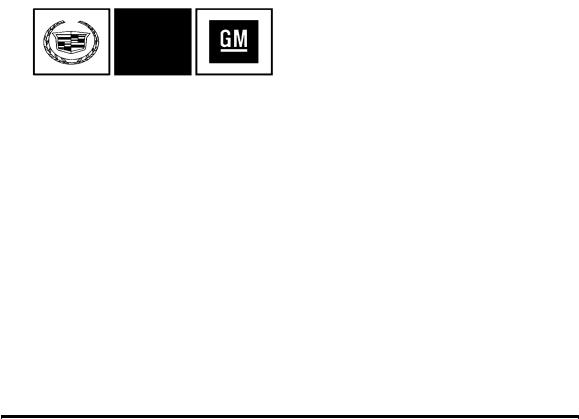
The names, logos, emblems, slogans, vehicle model names, and vehicle body designs appearing in this manual including, but not limited to, GM, the GM logo, CADILLAC, the CADILLAC Crest and Wreath, and STS are trademarks and/or service marks of General Motors LLC, its subsidiaries, affiliates, or licensors.
This manual describes features that may or may not be on your specific vehicle either because they are options that you did not purchase or due to changes subsequent to the printing of this owner manual. Please refer to the purchase documentation relating to your specific vehicle to confirm each of the features found on your vehicle. For vehicles first sold in Canada, substitute the name “General Motors of Canada Limited” for Cadillac Motor Division wherever it appears in this manual.
Keep this manual in the vehicle for quick reference.
Canadian Owners
Propriétaires Canadiens
A French language copy of this manual can be obtained from your dealer or from:
On peut obtenir un exemplaire de ce guide en français auprès du concessionnaire ou à l'adresse suivante:
Helm, Incorporated
P.O. Box 07130
Detroit, MI 48207
1-800-551-4123
Numéro de poste 6438 de langue française
www.helminc.com
Index
To quickly locate information about the vehicle, use the index in the back of the manual. It is an alphabetical list of what is in the manual and the page number where it can be found.
Litho in U.S.A. |
©2010 General Motors LLC. All Rights Reserved. |
||
Part No. 20853798 A First Printing |
|||
|
|
|
iii |
|
|
|
|
|
|
|
|

Safety Warnings and Symbols
Warning messages found on vehicle labels and in this manual describe hazards and what to do to avoid or reduce them.
Danger indicates a hazard with a high level of risk which will result in serious injury or death.
Warning or Caution indicates a hazard that could result in injury or death.
{ WARNING:
These mean there is something that could hurt you or other people.
Notice: This means there is something that could result in property or vehicle damage. This would not be covered by the vehicle's warranty.
A circle with a slash through it is a safety symbol which means “Do Not,” “Do not do this,” or “Do not let this happen.”
Vehicle Symbols
The vehicle has components and labels that use symbols instead of text. Symbols are shown along with the text describing the operation or information relating to a specific component, control, message, gauge,
or indicator.
M : This symbol is shown when you need to see your owner manual for additional instructions or information.
* : This symbol is shown when you need to see a service manual for additional instructions or information.
iv

Vehicle Symbol Chart
Here are some additional symbols that may be found on the vehicle and what they mean. For more information on the symbol, refer to the Index.
9 : Airbag Readiness Light
# : Air Conditioning
! : Antilock Brake System (ABS)
g : Audio Steering Wheel Controls or OnStar® $ : Brake System Warning Light
" : Charging System
I : Cruise Control
B : Engine Coolant Temperature
O : Exterior Lamps
# : Fog Lamps
. : Fuel Gauge
+ : Fuses
3 : Headlamp High/Low-Beam Changer
j : LATCH System Child Restraints
* : Malfunction Indicator Lamp
: : Oil Pressure
} : Power
/ : Remote Vehicle Start
> : Safety Belt Reminders
7 : Tire Pressure Monitor
F : Traction Control
M : Windshield Washer Fluid
v

2 NOTES
vi

Section 1 In Brief
Instrument Panel . . . . . . . . . . . . . . . . . . . . . . . . . . . . . . . . . . . 1-2
Initial Drive Information . . . . . . . . . . . . . . . . . . . . . . . . . . . 1-4 Remote Keyless Entry (RKE) System . . . . . . . . . . . 1-4 Remote Vehicle Start . . . . . . . . . . . . . . . . . . . . . . . . . . . 1-4 Door Locks . . . . . . . . . . . . . . . . . . . . . . . . . . . . . . . . . . . . . 1-5 Trunk . . . . . . . . . . . . . . . . . . . . . . . . . . . . . . . . . . . . . . . . . . . 1-6 Windows . . . . . . . . . . . . . . . . . . . . . . . . . . . . . . . . . . . . . . . . 1-6 Seat Adjustment . . . . . . . . . . . . . . . . . . . . . . . . . . . . . . . . 1-7 Memory Features . . . . . . . . . . . . . . . . . . . . . . . . . . . . . . . 1-8 Heated Seats (Front) . . . . . . . . . . . . . . . . . . . . . . . . . . . . 1-8 Heated Seats (Rear) . . . . . . . . . . . . . . . . . . . . . . . . . . . . 1-9 Heated and Ventilated Seats . . . . . . . . . . . . . . . . . . . . 1-9 Head Restraint Adjustment . . . . . . . . . . . . . . . . . . . . . . 1-9 Safety Belt . . . . . . . . . . . . . . . . . . . . . . . . . . . . . . . . . . . . . 1-10 Sensing System for Passenger Airbag . . . . . . . . . 1-10 Mirror Adjustment . . . . . . . . . . . . . . . . . . . . . . . . . . . . . . 1-11 Steering Wheel Adjustment . . . . . . . . . . . . . . . . . . . . 1-12 Interior Lighting . . . . . . . . . . . . . . . . . . . . . . . . . . . . . . . . 1-12 Exterior Lighting . . . . . . . . . . . . . . . . . . . . . . . . . . . . . . . 1-13 Windshield Wiper/Washer . . . . . . . . . . . . . . . . . . . . . . 1-14 Climate Controls . . . . . . . . . . . . . . . . . . . . . . . . . . . . . . . 1-15 Transmission . . . . . . . . . . . . . . . . . . . . . . . . . . . . . . . . . . 1-15
Vehicle Features . . . . . . . . . . . . . . . . . . . . . . . . . . . . . . . . . . 1-16 Radio(s) . . . . . . . . . . . . . . . . . . . . . . . . . . . . . . . . . . . . . . . 1-16 Satellite Radio . . . . . . . . . . . . . . . . . . . . . . . . . . . . . . . . . 1-17
Steering Wheel Controls . . . . . . . . . . . . . . . . . . . . . . . 1-18 Bluetooth® . . . . . . . . . . . . . . . . . . . . . . . . . . . . . . . . . . . . . 1-18
Navigation System . . . . . . . . . . . . . . . . . . . . . . . . . . . . . 1-18 Driver Information Center (DIC) . . . . . . . . . . . . . . . . 1-19 Vehicle Personalization . . . . . . . . . . . . . . . . . . . . . . . . 1-20 Cruise Control . . . . . . . . . . . . . . . . . . . . . . . . . . . . . . . . . 1-20 Power Outlets . . . . . . . . . . . . . . . . . . . . . . . . . . . . . . . . . 1-21
Performance and Maintenance . . . . . . . . . . . . . . . . . . 1-21
Traction Control System (TCS) . . . . . . . . . . . . . . . . 1-21 StabiliTrak® System . . . . . . . . . . . . . . . . . . . . . . . . . . . 1-21
Tire Pressure Monitor . . . . . . . . . . . . . . . . . . . . . . . . . . 1-22 Tire Sealant and Compressor Kit . . . . . . . . . . . . . . 1-22 Engine Oil Life System . . . . . . . . . . . . . . . . . . . . . . . . 1-22 Driving for Better Fuel Economy . . . . . . . . . . . . . . . 1-23
Roadside Service . . . . . . . . . . . . . . . . . . . . . . . . . . . . . . 1-23 OnStar® . . . . . . . . . . . . . . . . . . . . . . . . . . . . . . . . . . . . . . . 1-24
1-1
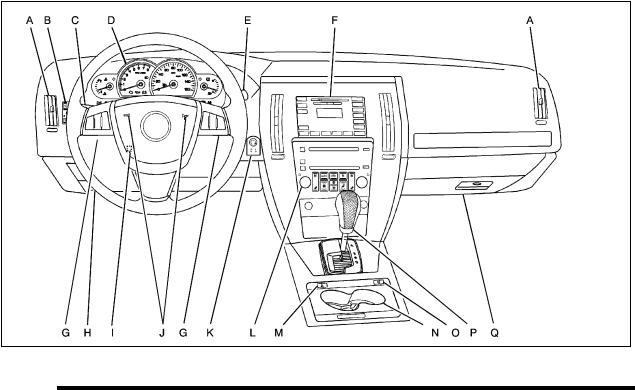
Instrument Panel
1-2

A.Outlet Adjustment on page 4 48.
B.Instrument Panel Brightness on page 4 35.
DIC Operation and Displays on page 4 70.
Head-Up Display (HUD) on page 4 38
(If Equipped).
C.Turn Signal/Multifunction Lever on page 4 4.
Headlamps on page 4 27.
Cruise Control on page 4 12.
Adaptive Cruise Control on page 4 15
(If Equipped).
Forward Collision Alert (FCA) System on page 4 6 (If Equipped).
D.Instrument Panel Cluster on page 4 52.
E.Windshield Wipers on page 4 10.
F.Audio System(s) on page 4 94.
Navigation/Radio System on page 4 113
(If Equipped).
G.Audio Steering Wheel Controls on page 4 124
(If Equipped).
Adaptive Cruise Control on page 4 15
(If Equipped).
Heated Steering Wheel on page 4 4
(If Equipped).
H.Data Link Connector (DLC). See Malfunction Indicator Lamp on page 4 62.
I.Power Tilt Wheel and Telescopic Steering Column on page 4 3.
J.Horn on page 4 3.
K.Ignition Positions on page 3 26.
L.Dual Climate Control System on page 4 43.
M.Hazard Warning Flashers on page 4 3.
N.Cupholders on page 3 56.
O.Traction Control System (TCS) on page 5 9.
P.Shift Lever. See Automatic Transmission Operation on page 3 30.
Q.Glove Box on page 3 56.
1-3
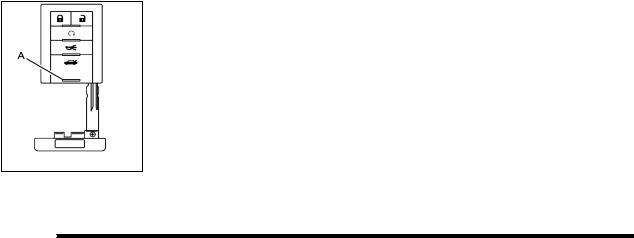
Initial Drive Information
This section provides a brief overview about some of the important features that may or may not be on your specific vehicle.
For more detailed information, refer to each of the features which can be found later in this owner manual.
Remote Keyless Entry (RKE) System
The keyless access transmitter is used to lock and unlock the doors from up to 60 m (195 feet) away from the vehicle.
Press K to unlock the driver door. Press again within five seconds to unlock all remaining doors.
Press Q to lock all doors.
Lock and unlock feedback can be personalized.
Press and hold V to open the trunk.
Press L and release to locate the vehicle.
Press and hold L for three seconds to sound the panic alarm.
Press L again to cancel the panic alarm.
Press the button (A) to remove the key. The key can be used for all locks.
See Keys on page 3 3 and Keyless Access System Operation on page 3 5.
Remote Vehicle Start
With this feature the engine can be started from outside of the vehicle.
Starting the Vehicle
1.Aim the remote keyless access transmitter at the vehicle.
2.Press Q.
3.Immediately after completing Step 2, press and hold / until the turn signal lamps flash.
1-4

When the vehicle starts, the parking lamps will turn on and remain on as long as the engine is running. The doors will be locked and the climate control system may come on.
The engine will continue to run for 10 minutes. Repeat the steps for a 10-minute time extension. Remote start can be extended only once.
Canceling a Remote Start
To cancel a remote start:
.Aim the RKE transmitter at the vehicle and press and hold / until the parking lamps turn off.
.Turn on the hazard warning flashers.
.Press the Acc. button (ignition switch).
. Turn on the valet lockout switch.
See Remote Vehicle Start on page 3 10.
Door Locks
There are several ways to lock and unlock the vehicle.
From the outside:
.Pull the front door handle. If the vehicle has a keyless access transmitter, the vehicle recognizes the transmitter and automatically unlocks the door.
.Another way to lock or unlock the vehicle, is to press Q or K on the keyless access transmitter. See Vehicle Personalization on page 3 59 for information on how to program the keyless access feature.
From the inside:
.Press the power door lock switch located on each front door. See Power Door Locks on page 3 13 for more information.
.Push down or pull up on the manual door lock knob for the rear door. The knob is located at the top of the door panel near the window.
Power Door Locks
On vehicles with power door locks, the switches are located on the front doors.
": Press to unlock the doors.
Q : Remove the key from the ignition and press to lock the doors.
1-5
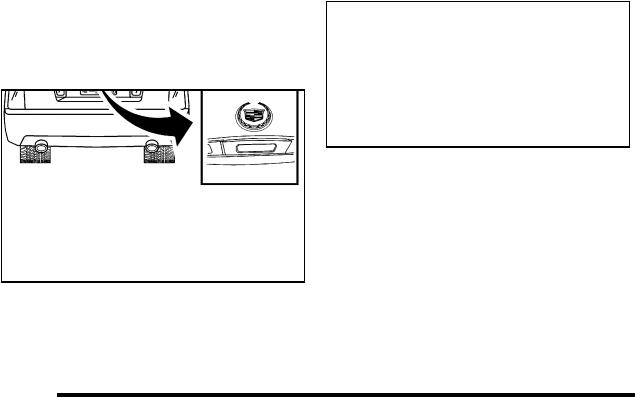
Trunk
Trunk Lid Release
There are three ways to open the trunk lid.
.Press the V button located on the driver door.
.Press V on the keyless access transmitter.
.Squeeze the trunk release button located on the rear of the trunk lid above the license plate.
See Trunk on page 3 15 for more information.
Windows
The power window switches are located on the armrest near each window. Press the front of the switch to the first position to open the window to the desired level. Lift up the front of the switch to the first position to close the window.
See Windows on page 3 18 for more information.
See Power Windows on page 3 19 for more information.
1-6
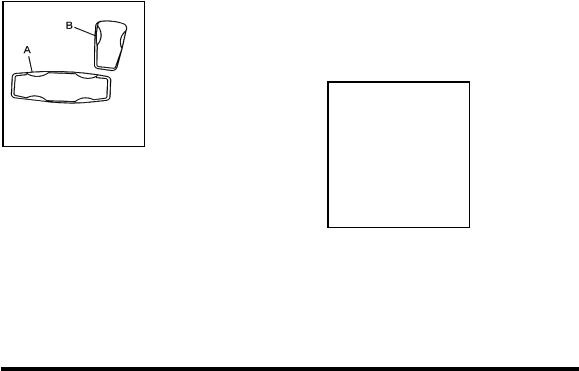
Seat Adjustment
Power Seats
The power seat controls are on the outboard side of the seat(s).
Move the seat forward or rearward by moving the control (A) forward or rearward.
Raise or lower the front or rear of the seat cushion by moving the front or rear of the control (A) up or down.
See Power Seats on page 2 2.
Power Reclining Seatbacks
The control is located on the outboard side of the seat(s).
To raise or recline the seatback, tilt the top of the control (B) forward or rearward.
See Power Reclining Seatbacks on page 2 10.
Power Lumbar Adjustment
The control is located on the outboard side of the front seat(s).
Press the front or rear of the control to increase or decrease lumbar support.
Press the top or bottom of the control to raise or lower the position of the lumbar support.
See Power Lumbar on page 2 3.
1-7

Memory Features
If the vehicle has the memory feature, you can program and recall memory settings for the following features for up to two drivers:
.The driver seat
.The outside rearview mirrors
.The power tilt wheel and telescopic steering column
The following settings and presets are set automatically:
.The language, radio and XM™ presets, tone, volume, playback mode (AM/FM or CD), last displayed stations, and compact disc position
.The last climate control setting
.The Head-Up Display (HUD) position, if your vehicle has this feature
.Other personalization settings, for example, remote start settings
See Memory Seat, Mirrors and Steering Wheel on page 2 5 and Vehicle Personalization on
page 3 59 for more information.
For vehicles with the base audio system, memory features are programmed and recalled using the radio menu.
For vehicles with the Navigation system, memory features are programmed and recalled using the navigation display or voice commands. See “Personalization” and “Voice Recognition” in the Index of the Navigation System manual for more information.
Heated Seats (Front)
On vehicles with heated front seats, the buttons are located on the climate control panel.
z: Press the up or down arrow to turn on the heated seat at the highest or lowest setting.
Press the up or down arrows a second time to raise or lower the setting. Press the down arrow until the indicator on the climate control displays is off.
See Heated Seats on page 2 4 for more information.
1-8
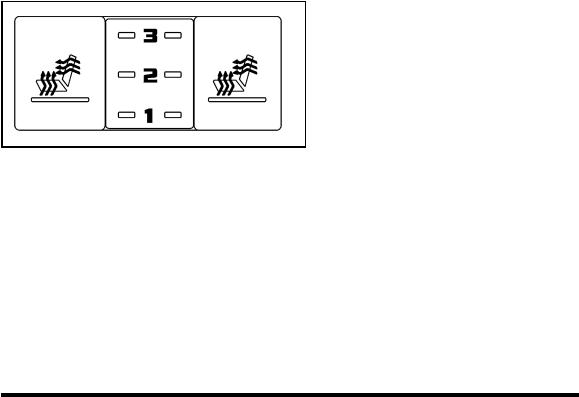
Heated Seats (Rear)
If the vehicle has this feature, the controls are on the rear of the center console.
Press the button once for the highest setting. With each press of the button, the heated seat will change to the next lower setting, and then to the off setting. The lights indicate “3” for the highest setting and “1” for the lowest.
See Heated Seats on page 2 14 for more information.
Heated and Ventilated Seats
On vehicles with heated and ventilated seats, the buttons are located on the climate control panel.
z : Press to heat the seat and seatback.
{ : Press to ventilate the seat.
For more information see Heated and Ventilated Seats on page 2 5.
Head Restraint Adjustment
Do not drive until the head restraints for all occupants are installed and adjusted properly.
To achieve a comfortable seating position, change the seatback recline angle as little as necessary while keeping the seat and the head restraint in the proper position.
For more information see Head Restraints on page 2 12 and Power Seats on page 2 2.
1-9
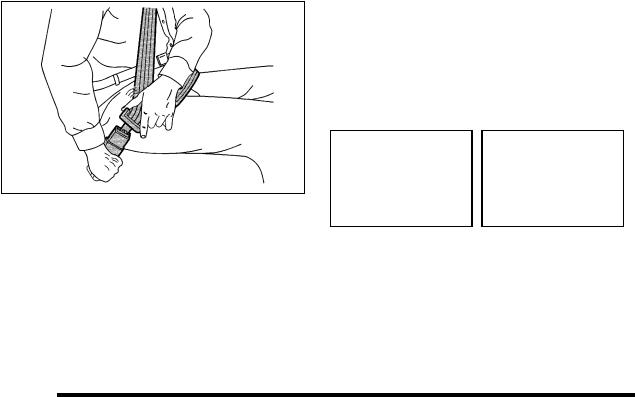
Safety Belt
Refer to the following sections for important information on how to use safety belts properly.
.Safety Belts: They Are for Everyone on page 2 14.
.How to Wear Safety Belts Properly on page 2 19.
.Lap-Shoulder Belt on page 2 28.
.Lower Anchors and Tethers for Children (LATCH) on page 2 45.
Sensing System for Passenger Airbag
The passenger sensing system will turn off the right front passenger frontal airbag under certain conditions. The driver airbag, seat mounted side impact airbags and the roof rail airbags are not affected by the passenger sensing system.
The passenger airbag status indicator will be visible on the overhead console when the vehicle is started.
United States |
Canada |
See Passenger Sensing System on page 2 66 for important information.
1-10
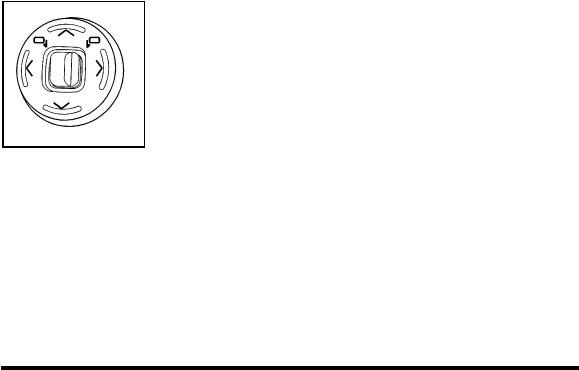
Mirror Adjustment
Exterior Mirrors
Controls for the outside power mirrors are located on the driver door.
1.Move the selector switch left or right to choose the driver side or passenger side mirror.
2.Press one of the four arrows located on the control pad to move the mirror to the desired direction.
3.Return the selector switch to the center position when finished adjusting.
The preferred mirror positions can be stored with the memory option. See Memory Seat, Mirrors and Steering Wheel on page 3 75.
The dimming feature automatically adjusts the driver outside mirror for the glare of the headlamps behind your vehicle. See Automatic Dimming Rearview Mirror on page 3 37 for more information.
Manually fold the mirrors inward to prevent damage when going through an automatic car wash. To fold, push the mirror toward the vehicle. Push the mirror outward, to return to its original position.
Interior Mirror
The vehicle has an automatic dimming inside rearview mirror. Automatic dimming reduces the glare of lights from behind the vehicle. The dimming feature comes on and the indicator light illuminates each time the vehicle is started.
See Automatic Dimming Rearview Mirror on page 3 37 for more information.
1-11
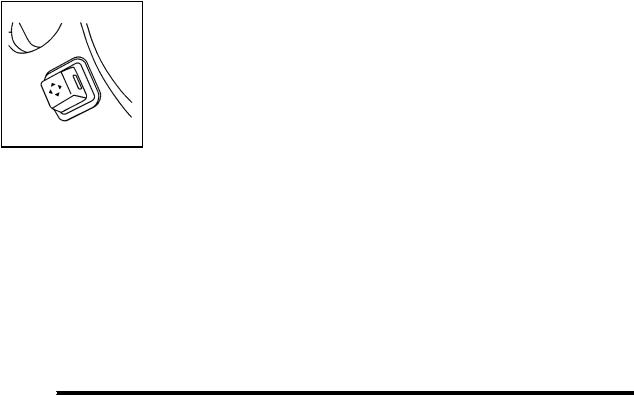
Steering Wheel Adjustment
The power tilt and telescope wheel control is located on the left side of the steering column.
To adjust the steering wheel:
.Push the control up or down to tilt the steering wheel up or down.
.Push the control forward or rearward to move the steering wheel towards the front or rear of the vehicle.
See Power Tilt Wheel and Telescopic Steering Column on page 4 3.
Interior Lighting
Reading Lamps
The reading lamps are located on the overhead console. These lamps come on automatically when any door is opened.
For manual operation, press the button next to each lamp to turn it on or off.
If the reading lamps are left on, they automatically shut off 10 minutes after the ignition has been turned off.
For more information on interior lamps, see:
.Reading Lamps on page 4 36.
.Entry Lighting on page 4 36.
.Instrument Panel Brightness on page 4 35.
1-12
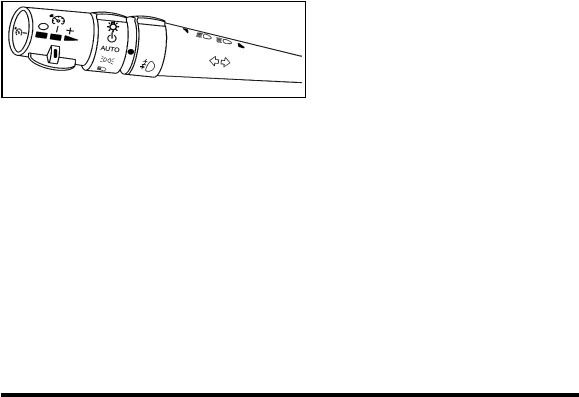
Exterior Lighting
The exterior lamp control is located in the middle of the turn signal/multifunction lever.
O: Turn the control with this symbol on it to operate the exterior lamps.
The exterior lamp control has four positions:
O: Turns off all lamps and automatic lighting features, including Daytime Running Lamps (DRL) and IntelliBeam®.
AUTO: Turns the exterior lamps on and off automatically depending upon how much light is outside of the vehicle.
;: Turns on the parking lamps together with the sidemarker, taillamps, license plate lamps, and instrument panel lights.
5: Turns on the headlamps together with the parking lamps, sidemarker, taillamps, license plate lamps, and instrument panel lights.
For more information, see:
.Headlamps on page 4 27.
.Daytime Running Lamps (DRL) on page 4 32.
.Fog Lamps on page 4 33.
1-13

Windshield Wiper/Washer
The windshield wiper lever is on the right side of the steering column.
Move the lever to select the wiper speed:
7 : Single wipe, move to 7and then release it. The lever will return to its original position. For several wipes, hold the lever in this position.
9 : Turns the windshield wipers off.
& : For a delayed wiping cycle, move the lever
to &and turn the delay adjustment band to adjust the frequency of wipes.
x : Turn the band up for more frequent wipes or down for less frequent wipes. The windshield wiper lever must
be set to &for this feature to work.
6 : Slow wipes.
1 : Fast wipes.
See Windshield Wipers on page 4 10 and Windshield Washer on page 4 11.
1-14
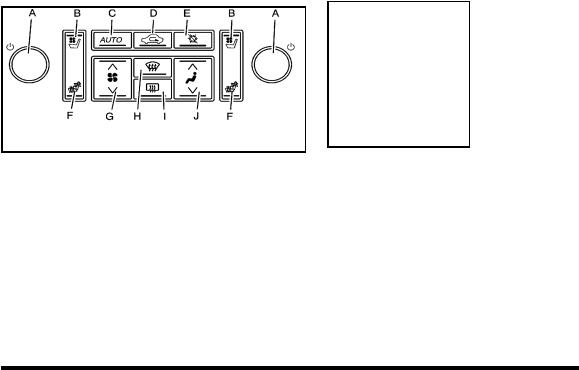
Climate Controls
The heating, cooling, and ventilation can be controlled for the vehicle with this system.
Vehicles With Heated and Ventilated Seats Shown,
Vehicles Without Similar
A. Driver and Passenger |
F. Heated Seat |
Side Power Buttons |
G. Fan Control |
|
|
B. Ventilated Seat |
H. Defrost |
|
|
C. AUTO |
I. Rear Window |
|
|
D. Air Recirculation |
Defogger |
E. Air Conditioning |
J. Air Delivery Mode |
|
Control |
See Dual Climate Control System on page 4 43 and Rear Climate Control System on page 4 49.
Transmission
Driver Shift Control (DSC)
Driver Shift Control (DSC) allows you to shift an automatic transmission similar to a manual transmission. To use the DSC feature:
1.Move the shift lever to the right from D (Drive) into the DSC area.
The vehicle will be in sport mode. It will remain in sport mode if the shift lever is not moved forward or rearward. Sport mode will shift the transmission automatically but remain in a gear longer than
it would in D (Drive) based on braking and acceleration.
1-15
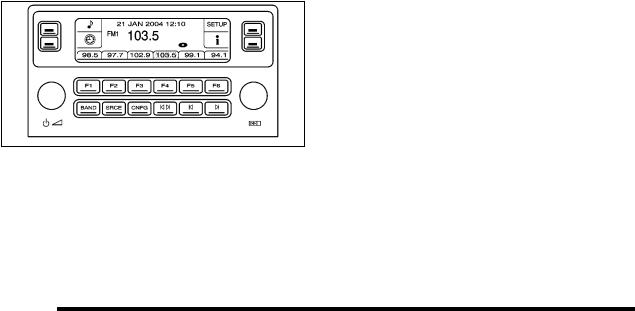
2.Press the shift lever forward to upshift or rearward to downshift. See Automatic Transmission Operation on page 3 30.
Vehicle Features
Radio(s)
Radio with CD
O: Press to turn the system on and off.
n: Turn to increase or to decrease the volume.
SRCE: Press to select between the radio or the CD player.
BAND: Press to select FM1, FM2, AM, or XM1 or XM2. w: Turn to select radio stations.
© ¨ : Seek or scan stations.
For more information about these and other radio features, see Radio(s) on page 4 95.
Setting Preset Stations
Up to 30 stations (six FM1, six FM2, six AM, six XM1 and six XM2), can be programmed on the six numbered pushbuttons.
To program preset stations:
1.Tune to a station and select the equalization, DSP, or PTY (program type) setting if desired.
2.Press and hold one of the six numbered pushbuttons for two seconds until a beep sounds. The set preset station number displays above the set pushbutton. If the numbered pushbutton is pressed for less then two seconds, the radio tunes to the station set to that pushbutton.
3.Repeat the steps for each pushbutton.
For more information, see Radio(s) on page 4 95.
1-16

Setting the Clock
To adjust the time:
1.Press w, located on the radio, to enter the main menu.
2.Turn wuntil SET CLOCK displays.
3.Press wto select SET CLOCK.
4.Turn wto adjust the time.
5.Press wto update the time and VEHICLE TIME UPDATED displays.
To adjust the date:
1.Press wto enter the main menu.
2.Turn wuntil SET DATE displays.
3.Press wto select SET DATE.
4.Turn wto adjust the date.
5.Press wto update the date and VEHICLE DATE UPDATED displays.
Satellite Radio
XM is a satellite radio service that is based in the 48 contiguous United States and 10 Canadian provinces. XM satellite radio has a wide variety of programming and commercial-free music, coast-to-coast, and in digital-quality sound.
A fee is required to receive the XM service.
For more information, refer to:
.www.xmradio.com or call 1-800-929-2100 (U.S.)
.www.xmradio.ca or call 1-877-438-9677 (Canada)
See “XM Satellite Radio Service” under Radio(s) on page 4 95.
1-17

Steering Wheel Controls
The vehicle has audio steering wheel controls and they could differ depending on the vehicle’s options.
¨ SEEK © : Press to go to the next or previous radio station or track on a CD.
SRCE: Press to select between AM, FM, XM™, or CD.
SCAN: Press and hold to scan radio stations.
y z : Press to go to the next or previous radio station stored as a favorite or tack on a CD.
+ e −: Press to increase or to decrease the volume.
b g : Press and release to silence the vehicle speakers only. Press and release again to turn the sound on.
1-18
For vehicles with Bluetooth®, OnStar®, or a navigation system, press and hold to interact with those systems.
Bluetooth®
For vehicles with an in-vehicle Bluetooth system, it allows users with a Bluetooth enabled cell phone to make and receive hands-free calls using the vehicle’s audio system and controls.
The Bluetooth enabled cell phone must be paired with the in-vehicle Bluetooth system before it can be used in the vehicle. Not all phones will support all functions. For more information visit www.gm.com/bluetooth.
For more information, see Bluetooth® on page 4 113.
Navigation System
The vehicle's navigation system (if equipped) provides detailed maps of most major freeways and roads throughout the United States and Canada. After a destination has been set, the system provides turn-by-turn instructions for reaching the destination. In addition, the system can help locate a variety of points of interest (POI), such as banks, airports, restaurants, and more.
See the Navigation System manual for more information.

Driver Information Center (DIC)
The DIC display is located at the bottom of the instrument panel cluster. It shows the status of many vehicle systems.
Without Head-Up |
With Head-Up |
Display (HUD) |
Display (HUD) |
The DIC buttons are located on the instrument panel, to the left of the steering wheel.
« 4 ª : Press to scroll through the available vehicle information displays which may include digital speed display, fuel range, fuel economy, fuel used, average speed, timer, battery voltage, tire pressure, engine oil life, and display units.
If you have an STS-V, the DIC also has additional vehicle information displays which include engine boost, engine oil temperature, oil pressure, and transmission fluid temperature.
AB 3 00 or 3 : Press to scroll through the odometer, trip odometer A and trip odometer B.
4 // : Press to reset certain DIC features and to acknowledge DIC warning messages and clear them from the DIC display.
EM: Press this button to change the display from English to metric.
« ~ ª : Press to change the position of the HUD on the windshield.
For more information about HUD, see Head-Up Display (HUD) on page 4 38.
For information on adjusting the instrument panel brightness, see Instrument Panel Brightness on page 4 35.
For more information, see Driver Information Center (DIC) on page 4 69.
1-19

Vehicle Personalization
Some vehicle features can be programmed by using the buttons on the remote keyless access transmitter and the buttons on the audio system. The features that can be programmed include:
.Driver Greeting
.Key Fob Reminder
.Remote Start
.Memory Features
.Lock and Unlock Feedback
.Lighting Features
.Door Lock and Unlock Settings
.Window Lock
.Chime Volume
.Suspension Mode
See Vehicle Personalization on page 3 59.
Cruise Control
These controls are located on the end of the multifunction lever.
9 : Turns the system off.
R : Turns the system on.
+ : Use this position to make the vehicle resume to a previously set speed or to accelerate.
T: Press to set the speed or to decrease the speed when cruise is already active.
[ : Press to disengage cruise control without erasing the set speed from memory.
See Cruise Control on page 4 12 and Adaptive Cruise Control on page 4 15 (If Equipped).
1-20

Power Outlets
Accessory power outlets can be used to plug in electrical equipment, such as a cellphone or MP3 player.
The vehicle has one outlet in front of the center console, one in the center console lid and there may be an additional outlet in the rear of the center console.
See Accessory Power Outlet(s) on page 4 42.
Performance and Maintenance
Traction Control System (TCS)
The traction control system limits wheel spin. The system turns on automatically every time the vehicle is started.
.To turn off traction control, press and release the t button located on the console. i illuminates when the system is turned off.
For more information, see Traction Control System (TCS) on page 5 9.
StabiliTrak® System
The StabiliTrak system assists with directional control of the vehicle in difficult driving conditions. The system turns on automatically every time the vehicle is started.
.To turn off both Traction Control and StabiliTrak, press and hold t, located on the console, until i illuminates and the appropriate DIC message displays. See DIC Warnings and Messages on page 4 76.
.Press and release the button again to turn on both systems.
For more information, see StabiliTrak® System on page 5 6.
1-21
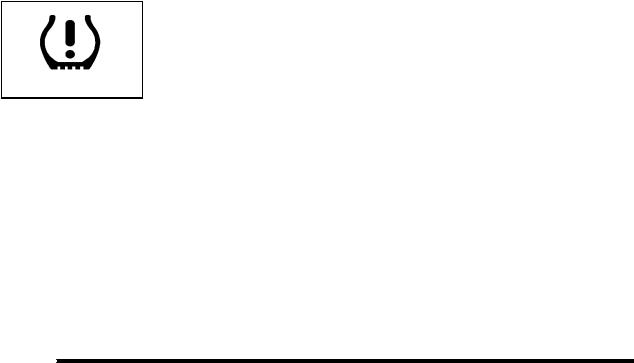
Tire Pressure Monitor
This vehicle may have a Tire Pressure Monitor System (TPMS).
The TPMS warming light alerts you to a significant loss in pressure of one of the vehicles tires.
If the warning light comes on, stop as soon as possible and inflate the tires to the recommended pressure shown on the tire loading information label. See
Loading the Vehicle on page 5 23. The warning light will remain on until the tire pressure is corrected.
During cooler conditions, the low tire pressure warning light may appear when the vehicle is first started and then turn off. This may be an early indicator that the tire pressures are getting low and the tires need to be inflated to the proper pressure.
The TPMS does not replace normal monthly tire maintenance. It is the driver’s responsibility to maintain correct tire pressures.
See Tire Pressure Monitor System on page 6 60 and Tire Pressure Monitor Operation on page 6 62.
1-22
Tire Sealant and Compressor Kit
This vehicle may come with a jack and spare tire or a tire sealant and compressor kit. The kit can be used to seal small punctures in the tread area of the tire.
See Tire Sealant and Compressor Kit (Without Selector Switch) on page 6 76 or Tire Sealant and Compressor Kit (With Selector Switch) on page 6 85 for complete operating information.
If the vehicle came with a jack and spare tire, see
Changing a Flat Tire on page 6 94.
Engine Oil Life System
The engine oil life system calculates engine oil life based on vehicle use and displays a DIC message when it is necessary to change the engine oil and filter. The oil life system should be reset to 100% only following an oil change.

Resetting the Oil Life System
1.Press the up or down arrow to scroll the DIC to show OIL LIFE.
2.Once the XXX% ENGINE OIL LIFE menu item is highlighted, press and hold the RESET button until the percentage shows 100%.
If the percentage does not return to 100% or if the CHANGE ENGINE OIL SOON message comes back on when the vehicle is started, the engine oil life system has not reset. Repeat the procedure.
See Engine Oil Life System on page 6 20.
Driving for Better Fuel Economy
Driving habits can affect fuel mileage. Here are some driving tips to get the best fuel economy possible.
.Avoid fast starts and accelerate smoothly.
.Brake gradually and avoid abrupt stops.
.Avoid idling the engine for long periods of time.
.When road and weather conditions are appropriate, use cruise control, if equipped.
.Always follow posted speed limits or drive more slowly when conditions require.
.Keep vehicle tires properly inflated.
.Combine several trips into a single trip.
.Replace the vehicle's tires with the same TPC Spec number molded into the tire's sidewall near the size.
.Follow recommended scheduled maintenance.
Roadside Service
U.S. or Canada: 1-800-882-1112
TTY Users: 1-888-889-2438
As the owner of a new Cadillac, you are automatically enrolled in the Roadside Service program which is available 24 hours a day, 365 days a year to give minor repair information or make towing arrangements.
For more information see Roadside Service on page 1 23.
Roadside Service and OnStar
If you have a current OnStar subscription, press
the Qbutton and the current GPS location will be sent to an OnStar Advisor who will assess your problem, contact Roadside Service, and relay exact location to get you the help you need.
1-23
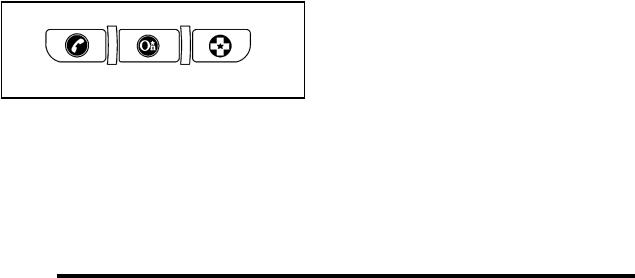
Online Owner Center
The Online Owner Center is a complimentary service that includes online service reminders, vehicle maintenance tips, online owner manual, special privileges and more.
Sign up today at: www.cadillacownercenter.com
(U.S.) or www.gm.ca (Canada).
OnStar®
For vehicles with an active OnStar subscription, OnStar uses several innovative technologies and live advisors to provide a wide range of safety, security, navigation, diagnostics, and calling services.
Automatic Crash Response
In a crash, built in sensors can automatically alert an OnStar advisor who is immediately connected to the vehicle to see if you need help.
How OnStar Service Works
Q: Push this blue button to connect to a specially trained OnStar advisor to verify your account information and to answer questions.
] : Push this red emergency button to get priority help from specially trained OnStar emergency advisors.
X : Push this button for hands free, voice activated calling and to give voice commands for Hands Free Calling and Turn by Turn Navigation.
Automatic Crash Response, Emergency Services, Crisis Assist, Stolen Vehicle Assistance, Vehicle Diagnostics, Remote Door Unlock, Roadside Assistance, Turn by Turn Navigation, and Hands Free Calling are available on most vehicles. Not all OnStar services are available on all vehicles. For more information, see the OnStar Owner's Guide; visit www.onstar.com (U.S.) or www.onstar.ca (Canada); contact OnStar at 1-888-4-ONSTAR (1 888 466 7827)
or TTY 1 877 248 2080; or press Qto speak with an OnStar advisor 24 hours a day, 7 days a week.
For a full description of OnStar services and system limitations, see the OnStar Owner's Guide in the glove box.
OnStar service is subject to the OnStar terms and conditions included in the OnStar Subscriber Information.
1-24
